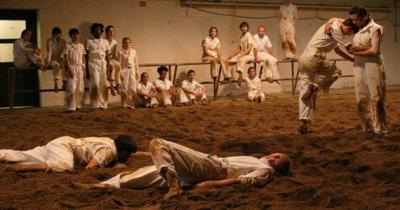Sweat, Dirt, and Collaboration: The process of DIRT

This year, Dance Uptown's glitz was replaced by grit- May 24-26, 2012, Dance Uptown: Dirt, premiered at Plumb Hall Agricultural Arena on the West Campus of The Ohio State University.
As a dance student in the show, I was intrigued by our dirt covered "stage." In true modern dance spirit, the faculty had thrown themselves bravely into the unknown, and we joined them- dancing, raking, digging, metal-detecting, hosing, and improvising along the way.
I was one of the eighteen dancers in Our Town, an original work by Bebe Miller. The first two weeks of studio rehearsals were surprisingly normal; Bebe taught us movement through repetition, each time emphasizing another nuance in the rhythm. This first phrase was the seed out of which much of our dance material grew. Bebe prompted us to create movement individually that accentuated different aspects of the phrase. The room was abuzz with pairs of dancers creating, observing, and experimenting. Bebe worked in depth with duets, offering new prompts and concepts.

We began our first “dirt” rehearsal in the arena with improvisation. We gathered in a semi-circle, dressed in our ratty clothes, both timid and enlivened by the dirt under our feet and the wooden beams high above our heads. We danced a twenty minute score, gradually closing the circle until we were all in the middle looking out. Group improvisations like this solidified the piece’s substance: our group living and moving together, watching and reacting to one another as we whirled in and out of duets, trios and ensembles. We were free to find our own quirky character, and the eclectic music of Richard Strauss, Toni Morrison, Alexander Scriabin, and Leonard Cohen provided the environment.
Esther Baker-Tarpaga's work, Oh Darling, the Dust never settles, made up the second act. The cast was inspired by the expansive space of the arena. Esther directed the dancers to each create movement based off of an animal, and she collaged the creations together.
Each of the twenty-one dancers’ costumes was just as unique as their movement. Early in the process, Esther worked closely with the department’s costume designer, Mary McMullen, to create a “post apocalyptic steampunk style.” The costumes and the movement informed each other, and both contributed to the fervently radical performance. Live music by Luis Obregon and Olivier Tarpaga, and a solo singing performance by dancer Natalia Hagan, accompanied the piece.
Josh Hines, a sophomore dance major, said that "the atmosphere changed everything about the piece, it's almost like two different shows, what you see in the arena you could never see on a stage." Josh said it takes more strength and energy to dance in the dirt, as most of us would agree. He noticed that atmosphere brought out a "greater sense of abandon in us, and pushed us to our limits."
Performing in Dance Uptown: Dirt was extreme and subtle, otherworldly and naturalistic. I will keep the newfound knowledge, visceral memories, and strong group bonds with me, even longer than the last grains of sand stuck between my toes.
– Ellen Maynard
